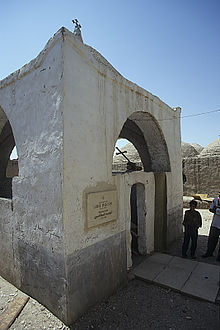Labib Habachi | |
|---|---|
| لبيب حبشي | |
 Tomb of Labib Habachi in Malqata | |
| Born | لبيب حبشي April 18, 1906 |
| Died | February 18, 1984 (aged 77) |
| Resting place | Monastery of St. Theodore, Malqata |
| Nationality | Egyptian |
| Occupation | Egyptologist |
Labib Habachi (لبيب حبشي; April 18, 1906 – February 18, 1984) was a Coptic Egyptian egyptologist.
Dr Habachi spent 30 years in the Antiquities Department of the Egyptian Government, ending his career as Chief inspector. During this period he spent an enormous amount of time in numerous dig sites in Egypt and the Sudan. He left government work to accept a position at the Oriental Institute of the University of Chicago as an Archaeological Consultant to its Nubian Expedition.
Between 1929 and 1939, Pierre Montet excavated at Tanis, finding the royal necropolis of the Twenty-first and Twenty-second Dynasties — the finds there almost equalled that of Tutankhamun's tomb in the Valley of the Kings. He believed that he found the location of Avaris, and this opinion was widely accepted at the time.
Yet Habachi was not convinced. In 1941-42 he worked at Tell el-Dab'a for the Egyptian Antiquities Service and came to the conclusion that this was in fact Avaris.
When a detailed study of the topography of the site and its surroundings was made by Manfred Bietak of the Austrian Archaeological Institute in the 1980s, Habachi's hypothesis was confirmed. Bietak's mission revealed that the actual Hyksos capital was indeed Tell al-Dab'a.
— [1]
Full bibliography in J. Kamil, Labib Habachi.[1]